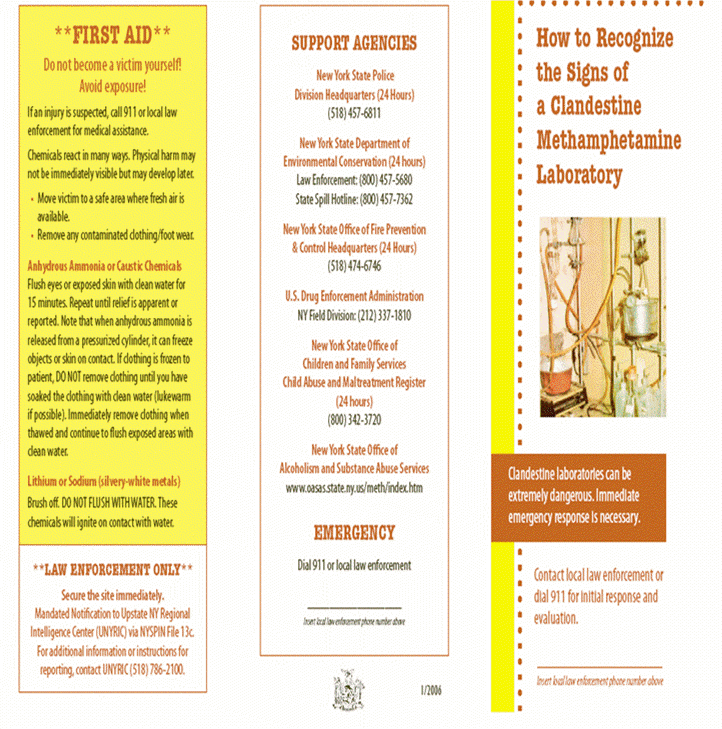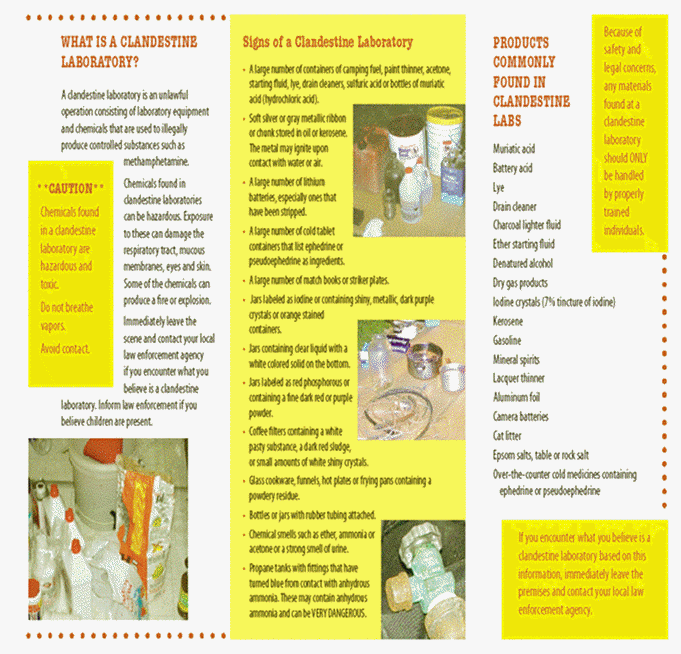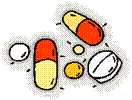DOH Medicaid Update April 2006 Vol. 21, No. 4
Office of Medicaid Management
DOH Medicaid Update
April 2006 Vol. 21, No. 4
State of New York
George E. Pataki, Governor
Department of Health
Antonia C. Novello, M.D., M.P.H., Dr. P.H.
Commissioner
Medicaid Update
is a monthly publication of the
New York State Department of Health,
Office of Medicaid Management
Brian Wing, Deputy Commissioner
Table of Contents
New Insurance Balancing Edit To Be Activated
Posting of Co-payment Information
Notice: New York State Medicaid Recipient Co-payments (English and Spanish Versions)
Family Health Plus Co-payment Information
Procedure Code Review Information
Certified Home Health Agency Services in Adult Care Facilities
2006 Clinical Practice Recommendations - American Diabetes Association
Mandated Child Abuse Reporters: Clandestine Methamphetamine Laboratories
Mandatory Generic Drug Program Update
Medicaid Recipients Cannot Be Billed
Claim Submission Methods (Correction to Article That Appeared in the March 2006 Edition)
Hepatitis C: Department Guidelines
Provider Services
Attention
All Providers
Electronic
Remittance Advices
Return to Table of Contents

Your Medicaid remittance statement can be sent to you electronically on Monday of the check date, over two weeks earlier than you would receive a mailed paper remittance.
eMedNY HIPAA remittance advices (835 and 820 transactions) may be delivered as electronic response files through the eMedNY eXchange or FTP.
To begin receiving remittances electronically, sign up for eMedNY eXchange or FTP. Electronic Remittance request forms are available online at:
Note: A separate form is needed for each ETIN used for submitting your claims.
Claims submitted on paper forms can also be included on an electronic remittance advice. To select this option, place an "X" in the box provided in item #4 on the Electronic Remittance Request Form.
If you need help interpreting the HIPAA standard remittance advices, a list of vendors is available at:
http://www.emedny.org/HIPAA/Vendors/NYSDOH%20SOFTWARE%20VENDOR%20LIST.pdf
Many of these vendors can generate a report from the electronic remittance.
Questions? Please call CSC at (800) 343-9000, select Option 5.
All Providers!
New Claim Edit
New Insurance Balancing Edit to be Activated
Return to Table of Contents
A new edit has been developed to ensure the correct entry of insurance information for procedure-based claims.
The 837 format requires that the insurance paid-amount (including Medicare), at the claim level, equals the sum of all the paid-amounts at the line level.
If these amounts do not match, the claim will fail Edit 2001!
Please refer to the Coordination of Benefits (COB) tutorial documents by accessing
http://www.emedny.org/hipaa/news/DOH_News/Tutorial1.doc
for an example of balancing requirements.
Instructions for ePACES:
You may enter the insurance paid amount on the line level only (the More button), or you may choose to enter the insurance amount paid on both the claim level (Other Payer tab) and on the individual lines.
However, if you enter the insurance paid amount in both places, the sum of the line level amounts must equal the claim level total. If the totals do not match, ePACES will display an error message.
If you have questions regarding this article, please contact the eMedNY Call Center at 800-343-9000.
Attention
Pharmacists
POSTING OF
CO-PAYMENT INFORMATION
Return to Table of Contents
To clarify Medicaid recipient co-payment information, we have updated a previously published notice which contains information pertinent to both provider and recipient responsibilities under the Medicaid Co-payment Program.


The notice, in both English and Spanish, is included on the following pages.
We strongly recommend that you post these notices in a location which is clearly visible to pharmacy customers.
Should recipients have questions concerning co-payment requirements, you should refer them to the notice or to the toll-free hotline number indicated at the bottom of the notice.
NOTICE
NEW YORK STATE MEDICAID RECIPIENT CO-PAYMENTS
Return to Table of Contents
The New York State Medicaid program charges a co-payment for many drug and medical supply items. A co-payment is a small amount of money you pay towards the cost of your care. The amounts you may be asked to pay are:
- $3.00 for Brand Name Drugs
- $1.00 for Generic Drugs
- $0.50 for Non Prescription (Over-The-Counter) Drugs
- $1.00 for Medical/Sickroom Supplies
You are required to pay the co-payment if you can afford it.
If you cannot afford to pay the co-payment, you should tell the pharmacy; they are still required to give you the drug. If the pharmacy gives you the drug and you do not pay the co-payment because you cannot afford to, you still owe the money to the pharmacy. (The State deducts the money from the pharmacy's payment, even if you don't pay.) They may ask you for the money the next time you come in, bill you, or use other legal means to collect the co-payments.
You should never go without a drug or medical service you need because you cannot afford the co-payment. You should also not refuse to pay the co-payment if you can afford to pay.
Note: There are certain drugs used to treat mental illness or tuberculosis, and drugs for family planning and emergency services which do not have a co-payment. Your pharmacist can tell you which drugs are exempt. There is a $200 per year limit on co-payments for any recipient. (The year starts April 1 of each year).
Also, the following Medicaid recipients are exempt from pharmacy co-payments:
- recipients under 21 years of age
- pregnant women
- recipients residing in an Adult Care Facility
- recipient enrolled in a Home and Community-Based Services (HCBS) waiver or Comprehensive Medicaid Case Management (CMCM) program
- residents in an Intermediate Care Facility for the Developmentally Disabled (ICF/DD)
- recipients living in residences certified by the New York State Offices of Mental Health or Mental Retardation and Developmental Disabilities
- certain institutionalized individuals
NOTE: This notice applies to New York Medicaid pharmacy co-payments. This information does not apply to Medicare Part D.
Questions about this program may be directed to the New York State Medicaid Co-payment Hotline at 800-541-2831.
NOTIFICACIÓN
CO-PAGOS DE BENEFICIARIOS DE MEDICAID DEL ESTADO DE
NUEVA YORK
Return to Table of Contents
El Programa de Medicaid establece un co-pago por medicamentos y suministros médicos. Un co-pago es una contribución mínima de dinero que usted paga por el costo de asistencia médica. Es probable que se le pida pagar los siguientes montos:
- $3.00 por medicamentos de marcas reconocidas
- $1.00 por medicamentos de marcas genéricas
- $0.50 por medicamentos de venta libre
- $1.00 por suministros médicos/de habitación
El co-pago es un requisito, se le pide pagarlo si puede hacerlo.
Si no puede pagar el co-pago, debe notificarlo a la farmacia; ellos están en la obligación de entregarle el medicamento. Aunque en la farmacia le entreguen el medicamento, y no pueda pagar el co-pago en ese momento, de todas maneras, usted le debe el dinero a la farmacia. (El Estado le descuenta a la farmacia el dinero del co-pago, aunque usted no lo pague cuando recibe el medicamento). Es probable que le exijan el pago en su próxima visita a la farmacia, le envíen la factura o usted sea sometido a procedimientos legales para la recuperación del monto adeudado.
Nunca debe dejar de adquirir el medicamento, o de solicitar servicios médicos que necesita porque no puede pagar el co-pago. Tampoco debe negarse a pagarlo, si tiene dinero para hacerlo.
Nota: Existen medicamentos para el tratamiento de enfermedades mentales, y para el tratamiento de la tuberculosis, que no requieren co-pago. El farmacéutico le indicará cuales medicamentos no requieren un co-pago. Los servicios de planificación familiar y los de emergencia, tampoco requieren un co-pago. Existe un máximo de $200 por beneficiario, en cuanto a la totalidad de co-pagos en un año. (El año empieza el 1ro. de abril de cada año).
Los siguientes beneficiarios no tienen que pagar el co-pago de farmacia:
- menores de 21 años de edad
- mujeres embarazadas
- beneficiarios que viven en un Centro de Cuidados para Adultos
- beneficiarios inscritos en los Servicios de Exención de Base Domiciliaria y Comunitaria (HCBS) y beneficiarios inscritos en el Programa de Administración Total de Casos de Medicaid (HCBS)
- residentes en un Centro de Atención Médica Intermedia para el Tratamiento de Incapacidades Evolutivas (ICF/DD)
- beneficiarios que viven en residencias autorizadas por la Oficina de Salud Mental, Oficina de Retardo Mental e Incapacidades Evolutivas
- Algunos individuos que están en instituciones
NOTA: Esta notificación aplica a co-pagos de farmacia de Medicaid del Estado de Nueva York y no a la Parte D de Medicare.
Si tiene preguntas acerca de los co-pagos de Medicaid del Estado de Nueva York, llame a la línea de información al 800-541-2831.
Attention
Pharmacists
Family Health Plus
Co-payment Information
Return to Table of Contents
On September 1, 2005, Family Health Plus (FHPlus) began charging a co-payment for many covered prescription medications; over-the-counter medications; and medical supply items.
A co-payment is the amount of money enrollees pay out-of-pocket towards the cost of their care. The amounts they may be asked to pay are:
- $6.00 for Brand Name Drugs.
- $3.00 for Generic Drugs.
- $ .50 for covered over-the-counter items, (e.g., insulin, smoking cessation products).
- $1.00 for covered medical supplies, (e.g., diabetic supplies, enteral formula, hearing aid batteries).
Enrollees are required to pay the co-payment even if they cannot afford to. If an enrollee cannot afford to pay the co-payment, he/she should tell the pharmacist. The pharmacist is still required to give the enrollee the medication. If the co-payment is not met, and the pharmacist gives the medication to the enrollee, the enrollee will still owes the co-payment to the pharmacy, (the health plan deducts the money from the pharmacy, even if the co-payment is not paid). The pharmacist can ask the enrollee for the money at their next visit; bill the enrollee; or use other legal means to collect the money owed.
Enrollees should never go without needed medication or medical services because of their inability to pay the co-payment.
Enrollees should not refuse to pay the co-payment - if they can afford to pay.
Co-payment Exemptions
Medications used to treat the following are exempt from co-payments:
- mental illness, or
- tuberculosis.
Covered family planning services, including prescription birth control are also exempt. Pharmacists should inform enrollees if the medication is exempt from co-payment.
People who are exempt include:
- People under 21 years of age.
- Pregnant women during pregnancy and the two months after the month in which the pregnancy ends.
- Residents of Adult Care Facilities licensed by the Department of Health (DOH) are not required to make pharmacy co-payments. Other co-pay requirements still apply.
- Permanent residents of a Nursing Home or community based residential facility.
- Residents of an Intermediate Care Facility for the Developmentally Disabled (ICF/DD).
- Residents of the Office of Mental Health (OMH); Residential Care Centers for Adults (RCAA); and Family Care homes (FC), but not adult homes.
Questions regarding FHPlus coverage should be directed to the member services department of the enrollee's health plan.
Attention
Practitioners and
Ordered Ambulatory Providers
Procedure Code
Review Information
Return to Table of Contents
The Division of Medical Review and Provider Enrollment will conduct prepayment review of the following procedure codes billed by practitioners and/or ordered ambulatory providers:
| 17000 | Destruction (e.g., laser surgery, electrosurgery, cryosurgery, chemosurgery, surgical curettement), all benign or premalignant lesions (e.g., actinic keratoses) other than skin tags or cutaneous vascular proliferative lesions; first lesion. |
| 36400 | Venipuncture, under age 3 years, necessitating physician's skill, not to be used for routine venipuncture; femoral or jugular vein. |
| 36405 | Venipuncture, under age 3 years, necessitating physician's skill, not to be used for routine venipuncture; scalp vein. |
| 36406 | Venipuncture, under age 3 years, necessitating physician's skill, not to be used for routine venipuncture; other vein. |
| 36425 | Venipuncture, cutdown; age 1 or over. |
| 76811 | Ultrasound, pregnant uterus, real time with image documentation, fetal and maternal evaluation plus detailed fetal anatomic examination, transabdominal approach; single or first gestation. |
| 90862 | Pharmacologic management, including prescription, use, and review of medication with no more than minimal medical psychotherapy. |
| 92014 | Ophthalmological services: medical examination and evaluation, with initiation or continuation of diagnostic and treatment program; comprehensive, established patient, one or more visits. |
| 92083 | Visual field examination, unilateral or bilateral, with interpretation and report; extended examination (e.g., goldmann visual fields with at least 3 isopters plotted and static determination within the central 30!, or quantitative, automated threshold perimetry, octopus program g-1, 32 or 42, humphrey visual field analyzer full threshold programs 30-2, 24-2, or 30/60-2). |
| 92568 | Acoustic reflex testing; threshold. |
| 94770 | Carbon dioxide, expired gas determination by infrared analyzer. |
| 95851 | Range of motion measurements and report (separate procedure); each extremity (excluding hand) or each trunk section (spine). |
| 95852 | Range of motion measurements and report (separate procedure); hand, with or without comparison with normal side. |
Effective for dates of service on or after May 1, 2006 the following providers will be required to submit paper claim forms with the appropriate documentation:
- Physicians,
- Ordered Ambulatory,
- Nurse Practitioners, and
- Optometry.
Documentation should be legible and include:
- Client Name,
- Date of Service, and
- Billing Provider.

Claims and documentation can be sent to:
PO Box 4601
Rensselaer, New York 12144-4601
Physician, Ordered Ambulatory, Nurse Practitioner and Vision Care provider manuals (version April 1, 2005) are available online at http://www.emedny.org/ProviderManuals/index.html
Also, within each manual, there is a new Provider Communication link which informs providers of changes in the manual. Please note that Pet Scan Codes (effective 1/1/06) have been revised and are included in this link.
Questions? Please call the Division of Medical Review and Provider Enrollment at: (800) 562-0856.
Certified Home Health Agency Services
In Adult Care Facilities
Return to Table of Contents

Recent audits have identified that some Certified Home Health Agencies (CHHAs) have inappropriately billed Medicaid for services rendered to Adult Care Facility (ACF) residents.
In accordance with Title 18 NYCRR 515.2(b)(1)(i)(c):
Medicaid reimbursement may not be made for services which duplicate/substitute for services that are required to be provided by another entity.
- Also, Medicaid does not pay for services rendered to a Medicaid recipient that are customarily provided free of charge to the general public.
- Additionally, when a service is covered by Medicaid and a recipient is service eligible, Medicaid is always the payer of last resort and Medicare and third party payers must first be billed for a covered service.
CHHAs are encouraged to review Appendix D of 92 ADM(Administrative Directive Memorandum)-15 , "Provision of Title XIX Home Care Services in Adult Care Facilities and Implementation of Retention Standards Waiver Program in Adult Homes and Enriched Housing Programs" prior to opening an ACF resident's case to service. Appendix D, "Guidelines for Service Responsibility," identifies:
- the service obligations that ACFs have to their residents, and
- the functions/services which Long Term Home Health Care Program Providers, CHHAs, and
- Personal Care Services providers are eligible to provide to qualified residents.
As there are several different types of ACF's, (e.g. adult homes, enriched housing programs, family-type homes, etc.), there may be some variances in an operator's service responsibility.
- ACF operators are generally responsible for meeting a resident's need for assistance with all nutritional and environmental support functions, (e.g. meals, laundry service, housekeeping tasks including bed making, ironing, and mending, shopping, bill paying and other essential errands).
- ACF operators are also responsible for meeting the needs of residents who require "some assistance" with completion of personal care services tasks, (e.g. bathing, dressing, grooming, toileting, walking/transferring, feeding, routine skin care, etc).
Service provision by a home care provider may be appropriate if a resident requires "total assistance" with a personal care task, assistance with a home health aide task, or has a skilled care need.
Some assistance and total assistance are identified in Title18 NYCRR505.14 as follows:
- "some assistance" means that a specific function or task is performed and completed by the patient with help from another individual.
- "total assistance" means that a specific function or task is performed and completed for the patient.
In instances when a CHHA is determined to have inappropriately provided Medicaid services to ACF residents, the Department will take appropriate action that may include recoupment of funds or sanctions. Moreover, CHHAs providing unnecessary services may be subject to citation of deficiencies upon surveillance.
When developing plans of care for ACF residents, it is the responsibility of the CHHA to take into account those services that are required to be provided by staff from the ACF and to reflect those obligations in the CHHA's plan of care and claim submissions.
For further information and clarification, 92 ADM-15 is available online at:
http://www.otda.state.ny.us/directives/1992/ADM/92_ADM-15.pdf
Appendix D, "Guidelines for Service Responsibility" is not available online and is included on the following pages.
Questions regarding this article may be directed to:
The Bureau of Long Term Care at (518) 474-6580
Or
The Office of Health Systems Management, Division of Home & Community Based Care, at (518) 408-1145.
| Home Care 1 | Adult Care Facility Responsibilities | |||||
| Service Functions (x indicates responsibility) | PC | CHHA | LTHHCP | Adult Homes | Enriched Housing | Family-Type Homes |
| Home Health Aide/Personal Care Services - Level l 2 | ||||||
| Making/Changing Beds | X | X | X | |||
| Dusting/Vacuuming Residence Bedroom | X | X | X | |||
| Light Cleaning of Bedroom/Bath | X | X | X | |||
| Dishwashing | X | X | X | |||
| Listing Needed Supplies | X | X | X | |||
| Shopping | X | X | X | |||
| Paying Bills/Doing Errands | X | X | X | |||
| Laundering Personal Items | X | X | X | |||
| Ironing/Mending | X | X | X | |||
| Preparing Meals (simple modern diets) | X | X | X | |||
| Home Health Aide/Personal Care Services - Level ll | ||||||
| Preparing Meals (modern diets, including diabetic, low-salt, and low-residue diets) | X | X | X | |||
| Bathing Some Assistance3 Total Assistance4 | X | X | X | X | X | X |
| Grooming (including hair care, shaving, nails, and teeth and mouth) Some Assistance3 Total Assistance4 | X | X | X | X | X | X |
| Dressing Some Assistance Total Assistance4 | X | X | X | X | X | X |
| Toileting Some Assistance Total Assistance4 | May Provide only in EH X X X | X | X | |||
| Walking Some Assistance Total Assistance4 | May Provide only in EH X X X | X | X | |||
| Transferring Some Assistance Total Assistance4 | May Provide only in EH X X X | X | X | |||
| Feeding Some Assistance Total Assistance4 | May Provide only in EH X X X | X | X | |||
| Administration of medication Some Assistance Total Assistance4 | X | X | X | X | X | X |
| Routine Skin Care Changing Simple Dressings | X X | X X | X X | |||
| Using Medical Supplies/Durable Medical Equipment Some Assistance Total Assistance | May Provide only in EH X X X | X | X | |||
| Personal Emergency Response Service | May Provide only in EH | |||||
| Home Health Aide5 | ||||||
| Using Prescriber Medical Equipment/Supplies/devices | X | X | ||||
| Changing Dressings of staple surface wounds | X | X | ||||
| Performing Simple Measurements/Tests to routinely monitor medical conditions, including taking vital signs | X | X | ||||
| Caring for an ostomy after the ostomy has achieved normal function | X | X | ||||
| Performing Maintenance Exercise Program | X | X | ||||
| Medical Transportation | X | |||||
| Medical Supplies/Equipment | X | X | ||||
| Physical Therapy | X | X | ||||
| Occupational Therapy | X | X | ||||
| Speech Therapy | X | X | ||||
| Radiology | X | X | ||||
| Laboratory | X | |||||
| Podiatry | X | |||||
| Dentistry | X | |||||
| Audiology | X | |||||
| Nursing Services | X | X | ||||
| Physician Services | X | X | ||||
| Waivered Services for LTHHCP65 | ||||||
| Meals | X | X | X | |||
| Nutritional Counseling | X | X | X | |||
| Home Maintenance Services Chore Services5 | X | X | X | |||
| Emergency Alarm Response System | May provide only in EH | X | X | |||
| Housing Improvement Services | X | X | X | |||
| Social Day Care | X | X | X | |||
| Respite Care | X | X | X | |||
| Medical Social Services | X | X | ||||
| Respiratory Therapy | X | X | ||||
Special Notations
- CHHA and LTHHCP providers may either provide directly or make arrangements for the provision of these services.
- There may be special circumstances occasioned by a medical condition in which the provision of Level l nutritional and environmental support functions would be appropriately performed by a home care provider.
- "Some assistance" means that a specific function or task is performed and completed by the resident with help from another individual.
- "Total assistance" means that a specific function or task is performed and completed for the resident.
- Some of the following tasks may be indicators of inappropriate retention for an ACF.
- Not all LTHHCP providers offer the full range of waivered services. CHHA providers routinely offer these services. As indicated by the chart, only a a few of these services are appropriately offered to ACF residents
2006 Clinical Practice Recommendations
American Diabetes Association
Return to Table of Contents
Diabetes is a major public health problem and is becoming more prevalent in all age groups:
- An estimated 20.8 million people in the United States, or 7% of the population, have diabetes.
- Of these, an estimated 14.6 million have been diagnosed with diabetes; while another 6.2 million are unaware they even have the disease.
Improving the health of New Yorkers is essential for the future of our state. In an effort to promote quality health outcomes, the chart on the following page was developed to summarize services that are covered by the New York State Medicaid Program in accordance with the 2006 Clinical Practice Recommendations of the American Diabetes Association.
Clinicians should assess their patients for diabetes risk factors and provide or refer their patients for services in accordance with the American Diabetes Association's clinical practice guidelines.
The Medicaid program reimburses for medically necessary care, services, and supplies for the diagnosis and treatment of diabetes.
For more information, please contact the Bureau of Program Guidance at (518) 474-9219.
Source:
NYS Department of Health, Diabetes Prevention & Control Program.
http://www.health.state.ny.us/diseases/conditions/diabetes/index.htm
American Diabetes Association, All About Diabetes.
http://www.diabetes.org/about-diabetes.jsp
| ADA Standard | ADA Frequency | Medicaid Covered |
|---|---|---|
Physician/Clinic Visit
| Each regular diabetes visit* | Yes |
Key Laboratory Tests
|
Semi-annually* As needed* As needed* Annually Annually Annually | Yes |
| Comprehensive Foot Exam | Annually* | Yes, when performed by primary care provider, or by a podiatrist for children ‹21 years of age or adults over age 64, or for medicare crossover patients. |
| Dilated Eye Exam by Ophthalmologist/Optometrist | Annually | Yes, the patient record must document medical necessity, if done more frequently that once every two years. |
| Self-Monitoring of Blood Glucose & Ketones | At least daily | Yes |
| Insulin Regimens | At least daily | Yes, all insulin products (prescription & OTC) are covered. |
| Coverage of Oral Medications including adjunctive medications: oral hypoglycemic agents, glucagon, antihypertensives, lipid-lowering agents, aspirin therapy, & other endocrine drugs | At least daily | Yes, all oral diabetic agents, adjuvant agents and injectable glucagon are covered. |
| Smoking Cessation Pharmacologic Coverage | As needed | Yes, all forms covered for 2 courses of therapy a year. |
| Annual Influenza Vaccine | Annually | Yes |
| Diabetes Supplies Diabetes daily care items:
Diabetes diagnostic agents
| As prescribed | Yes |
*More frequently based on medical necessity, **Medicaid Prior Approval required, ***Medicaid DVS required
For Persons that are Medicare/Medicaid "dual eligibles", the Medicaid program
supplements Medicare coverage and supplies that are available under the New York
State's Medicaid program. Services that are covered by both programs will be
paid first by Medicare and than by Medicaid.
Attention
Mandated Child
Abuse Reporters
Clandestine Methamphetamine
Laboratories
Return to Table of Contents
New York State recognizes the potential threat of methamphetamine to our public health and safety. Methamphetamine, also known as "meth", "crystal meth", "tina" or "speed", has been adversely affecting individuals in various communities throughout New York State. The physical effects of the drug on users are debilitating and sometimes irreversible. In addition, the methods of manufacturing methamphetamine are also extremely dangerous and pose a serious hazard to anyone in or near the location where it is being produced.
Legislation requires certain employers to provide information to their employees on recognizing unlawful methamphetamine laboratories.
- If you are an employer of persons mandated to report potential child abuse in New York State and your employees visit the residences of children, you must provide your employees with information on recognizing the signs of a clandestine methamphetamine laboratory.
These unlawful laboratories and the people who operate them can pose a serious threat. Dangerous chemicals are used and discarded when the drug is produced, and the people making the drug may be violent. Children and others who live on the premises are at risk from exposure to the toxic chemicals that are used or formed during the manufacturing process. Clandestine laboratories may also endanger others who visit them, including your employees.
The following two pages contain a new brochure entitled, "How to Recognize the Signs of a Clandestine Methamphetamine Laboratory". This brochure will aid employers with providing information to their employees.
- It is recommended that each employee who visits locations where children reside be given a copy of this brochure.
- If an employee suspects a methamphetamine laboratory, (s)he should leave the premises and contact local law enforcement.
The brochure was developed to assist mandated reporters, along with police, firefighters, ambulance personnel and any other interested party. It identifies and provides pictures of telltale signs and includes directions as to how to proceed and report the suspicion.
Additional information about methamphetamine and clandestine laboratories is available on the New York State Office of Alcoholism and Substance Abuse Services (OASAS) website at:


Changes
Effective
April 1, 2006
Mandatory Generic
Drug Program Update
Return to Table of Contents

The New York State Medicaid Mandatory Generic Drug Program requires prior authorization for brand-name prescriptions with an A-rated generic equivalent.
When the FDA approves new generic drugs, Medicaid allows the equivalent brand-name drug to be dispensed for a period of six months, without prior authorization, to assure that there is an adequate supply of the new generic readily available. The Medicaid program will begin posting brand name drugs and the effective date of the prior authorization requirement that meet this standard in the Medicaid Update and on the Department's web.
The following lists of drugs have had generic equivalents available for six months or more, and require prior authorization, effective April 1, 2006.
- Remaining refills of current prescriptions which were written prior to this date, but were filled on or after April 1, 2006, will not require prior authorization.
- However, when a current prescription expires, a prior authorization will be required for the patient to continue to receive the brand-name drug.
| AGRYLIN Capsule 0.5mg, 1mg | ORAPRED Soln 15mg/5ml |
| AMIKIN Vial 250 mg/ml | OXYCONTIN SA Tablet 10mg |
| ARAVA Tablet 10, 20mg | PAMELOR Soln 10mg/5ml |
| BIAXIN Tablet 250, 500mg | PARAPLATIN Vial 450mg/45ml |
| CARDIZEM CD Capsule 120mg, 180mg | PERIOSTAT Tablet 20mg |
| CELEXA Tablet 10mg ,20mg, 40mg | PLENDIL SA Tablet 5mg, 10mg |
| CELEXA solution 10mg/5 ml | PLETAL Tablet 50mg, 100mg |
| CLIMARA Patch 0.025mg, 0.075mg/day | REMERON Soltab 45mg |
| DESFERAL Vial 2gm | RETROVIR Tablet 300mg |
| ELOCON 0.1% Cream, Lotion | ROBINUL Tablet 1 MG |
| FIORINAL W/CODEINE #3 Capsule | ROBINUL FORTE Tablet 2mg |
| LOESTRIN 21 1/20 TABLET | ROXICODONE Tablet 15mg, 30mg |
| LOESTRIN FE 1.5/30 TABLET | TRIDESILON 0.05% Cream, Ointment |
| LOESTRIN FE 1/20 TABLET | ULTRACET Tablet |
| LOPROX Cream 0.77% | ULTRAVATE 0.05% Cream, Ointment |
| MAXIDONE Tablet 10/750mg | VIDEX EC SA Capsule 200mg, 250mg, 400mg |
| NORDETTE-28 Tablet | WELLBUTRIN SR Tablet 200mg |
This is a reminder to all hospitals, free-standing clinics and individual practitioners about the requirements of the Medicaid program related to requesting compensation from Medicaid recipients, including Medicaid recipients who are enrolled in a Medicaid managed care or Family Health Plus (FHPlus) plan.
MEDICAID RECIPIENTS CANNOT BE BILLED
Return to Table of Contents
Acceptance and Agreement
When a provider accepts a Medicaid recipient as a patient, the provider agrees to bill Medicaid for services provided or, in the case of a Medicaid managed care or Family Health Plus (FHPlus) enrollee, the recipient's managed care plan for services covered by the contract.
- The provider is prohibited from requesting any monetary compensation from the recipient, or his/her responsible relative, except for any applicable Medicaid co-payments.
- A provider may charge a Medicaid recipient, including a Medicaid or FHPlus recipient enrolled in a managed care plan, only when both parties have agreed prior to the rendering of the service that the recipient is being seen as a private pay patient.
- This agreement must be mutual and voluntary.
It is suggested that the provider maintain the patient's signed consent to be treated as private pay in the patient record.
A provider who participates in Medicaid fee-for-service may not bill Medicaid fee-for-service for any services included in a recipient's managed care plan, with the exception of family planning services, when the provider does not provide such services under a contract with the recipient's health plan.
A provider who does not participate in Medicaid fee-for-service, but who has a contract with one or more managed care plans to serve Medicaid managed care or FHPlus members, may not bill Medicaid fee-for-service for any services. Nor may any provider bill a recipient for services that are covered by the recipient's Medicaid managed care or FHPlus contract, unless there is prior agreement with the recipient that he/she is being seen as a private pay patient as described above. The provider must inform the recipient that the services may be obtained at no cost to the recipient from a provider that participates in the recipient's managed care plan.
Claim Submission
The prohibition on charging a Medicaid or FHPlus recipient applies:
- when a participating Medicaid provider or a Medicaid managed care or FHPlus participating provider fails to submit a claim to Computer Sciences Corporation (CSC) or the recipient's managed care plan within the required timeframe; or
- when a claim is submitted, to CSC or the recipient's managed care plan, and the claim is denied for reasons other than that the patient was not eligible for Medicaid or FHPlus on the date of service.
Collections
A Medicaid recipient, including a Medicaid managed care or FHPlus enrollee, must not be referred to a collection agency for collection of unpaid medical bills or otherwise billed, except for applicable Medicaid co-payments, when the provider has accepted the recipient as a Medicaid or FHPlus patient.
Providers may, however, use any legal means to collect applicable unpaid Medicaid co-payments.
Emergency Medical Care
A hospital that accepts a Medicaid recipient as a patient, including a Medicaid or FHPlus recipient enrolled in a managed care plan, accepts the responsibility of making sure that the patient receives all medically necessary care and services.
Other than for legally established co-payments, a Medicaid or FHPlus recipient should never be required to bear any out-of-pocket expenses for:
- medically necessary inpatient services; or,
- medically necessary services provided in a hospital based emergency room (ER).
This policy applies regardless of whether the individual practitioner treating the recipient in the facility is enrolled in the Medicaid program.
When reimbursing for ER services provided to Medicaid managed care or FHPlus enrollees, health plans must apply:
- the Prudent Layperson Standard;
- provisions of the Medicaid Managed Care/FHPlus Model Contract; and,
- Department directives.
Claiming Problems
If a problem arises with a claim submission, the provider must first contact CSC. If the claim is for a service included in the Medicaid managed care or FHPlus benefit package, the enrollee's managed care plan must be contacted. If CSC or the managed care plan is unable to resolve an issue because some action must be taken by the recipient's local department of social services (e.g., investigation of recipient eligibility issues), the provider must contact the local department of social services for resolution.
For questions regarding Medicaid managed care or FHPlus, please call the Office of Managed Care at (518) 473-0122.
For questions regarding Medicaid fee-for-service, please call the Office of Medicaid Management at (518) 473-2160.
Correction!
In the March 2006 edition, we stated that the length of time a Utilization Threshold Service Authorization for Pharmacy Transactions stays on file is 30 days. This is incorrect. The actual length of time Utilization Threshold Service Authorization for Pharmacy Transactions stays on file is 90 days. This article is reprinted in its entirely, with the correction made.
Claim Submission Methods
Return to Table of Contents
- Submission formats vary based upon provider type:
Provider Type Paper Claim Form Electronic Format Dental eMedNY 000201 837 Dental Transportation eMedNY 000201 837 Professional (837P) Fee for Service * eMedNY 150001 837 Professional (837P) Rate Based UB-92 837 Institutional (837I) Pharmacy eMedNY 000301 NCPDP
* Electronic Referred Ambulatory claims may be billed using the 837P or 837I format
- The following electronic submission methods are available at eMedNY:
- eMedNY eXchange
- eMedNY Gateway (BBS)
- CPU - CPU
- File Transfer Protocol (FTP)
- Electronic Provider Assisted Claim Entry System (ePACES) - HIPAA compliant web-based application
Note - Clinic and Inpatient billing must be submitted electronically.
To send or receive electronic claim information providers need the following:
- ETIN (Electronic Transmission Identification Number)
- Certification Statement
- Trading Partner Agreement
- User ID and Password
- Request for Electronic Remittance Advice (to receive 835 or 820)
Timing Is Everything
During the process of billing or rebilling Medicaid claims, questions about time constraints arise. Some of the most common of these questions regard "How Long" information is on the Medicaid system and "How Long" a claim is pended.
As a reference source, listed below are some time frames categorized by the following:

- Less than 30 days
- 30 days
- 60 days
- 90 days
- Greater than 90 days
Less Than 30 Days
- Medicaid checks and remits are held for two weeks and two days before mailing
30 Days
- Approximate payment time for claims (including check lag period)
- The length of time a Pharmacy claim is pending for "No UT Service Authorization On File"
60 Days
- The length of time a claim other than Pharmacy pends for "NO UT SERVICE AUTHORIZATION ON FILE"
90 Days
- Length of time to submit claims without a valid 90 day reason
- Length of time a UT Service Authorizartion stays on file for Pharmacy transactions
Greater than 90 Days
- 120 days (four months) - Length of time a UT Service Authorization stays on file, excluding Pharmacy (see above)
- Up to two years - Length of time to submit a claim with a valid 90 day reason
- Up to six years - Length of time to submit an adjustment or void to a previously paid claim
Additional Timing Information
Pending Claims
Question: How long will the claim stay in a pending status?
Answer: Claims remain in a pending status on the remittance statement for various time frames depending on the reason for the pend and the provider type.
Recycled Pends
Some claims are recycled and will be paid if during the pending period updated information is placed on eMedNY files. Examples of this would be Edit 00162 - Recipient Ineligible for Date of Service. In most instances, these claims are pended for 30 days. If the recipient eligibility information is updated in that time frame and no other errors are found, the claims are paid.
Another example of a recycled pending claim is Edit 01154 - No UT Service Authorization on File. These claims are put in a pending status for 60 days. (The exception is pharmacy claims, which are in a pending status for 30 days.) If the authorization is placed on file while the claim is pending and no other errors are found, the claims will be paid.
NYS Manual Review
Claims that are put in a pending status to be manually reviewed at a State office will pend for various time frames while the claim and/or associated documentation (reports) are reviewed.
Questions about this information should be directed to the eMedNY Provider Services Call Center at: (800) 343-9000.
Hepatitis C
Department Guidelines
Return to Table of Contents
Overview of Hepatitis C
Hepatitis C virus (HCV) infection is a major public health problem, a leading cause of chronic liver disease throughout the world, and the leading cause of death from liver disease in the United States (U.S.).1
- In New York State, there are an estimated 237,000 people with Chronic Hepatitis C (CHC), based on surveys from the Centers for Disease Control and Prevention (CDC).
These estimates of prevalence are likely conservative, because they do not include incarcerated and homeless persons, groups that have a high prevalence of HCV infection. HCV is transmitted primarily through percutaneous exposure to infected blood.
- At least two-thirds of the patients currently identified with CHC infection were infected through injection drug use.2
- Transfusion of blood or blood products is also strongly associated with the transmission of HCV.
Although transmission of HCV by transfusion has declined dramatically in the U.S. following the introduction of more sensitive serological tests for HCV in 1992, some patients transfused before adequate screening was available are still being identified. 2
Burden of HCV Infection
The total medical expenditures for persons with HCV in the U.S. are estimated to be $15 billion per year.
- It is estimated that HCV deaths will increase four-fold to 38,000, by the year 2010.
- The cost of premature disability and death (2010-2019) is expected to reach $75.5 billion.
- CHC accounts for at least 40% of liver transplants in the U.S. today and the number of HCV-infected patients with cirrhosis is estimated to double over the next 20 years. 1
Identifying and treating patients with bridging fibrosis or cirrhosis on liver biopsy best accomplishes reduction in complications of cirrhosis
Role of the Primary Care Provider
Primary care providers are considered the gatekeepers of healthcare in the U.S. and are in a key position to diagnosis those with hepatitis C. Unfortunately, many providers are not even aware of the risks associated with the disease and how to correctly diagnose it.
Recently, published articles have pointed out that not enough is being done by primary care providers to identify those at risk for and infected with hepatitis C. Some surveys have suggested that barriers exist to PCPs conducting risk assessment, screening and diagnosis of patients at-risk for HCV, and that a lack of understanding exists as to what the primary care provider's role is in co-managing the patient with HCV with the team of specialists (i.e., gastroenterology/hepatology, psychiatry, addiction medicine).
Since HCV is often silent until late in the disease process, it is important that primary care providers are able to correctly identify patients at risk for hepatitis C and to institute appropriate diagnostic testing, and referral for further evaluation with or without treatment, and counseling.
Clinical Guidelines for the Management of Hepatitis C
In 2004, the Department of Health convened a panel of experts in the field of HCV medical care, and consumers to develop these guidelines.
- The purpose of the guidelines is to provide clinicians with practical, state-of-the-art information on the diagnosis, medical management, and prevention of HCV infection. These guidelines are intended for the medical management of adults and children infected with HCV.
While the field of HCV medicine is still evolving, these guidelines review the currently available evidence to support the recommendations, and, where published data are lacking, present standards of care as recommended by the panel. A full copy of the guidelines can be found on the Department's Hepatitis Web page at:
http://www.health.state.ny.us/diseases/communicable/hepatitis/guidelines/index.htm
Guideline Highlights
Risk Assessment and Screening:
The guidelines highlight the need for primary care providers to take the lead role in risk assessing and screening for the common risk factors associated with hepatitis C infection. The guidelines recommend providers screen all persons with identified risk for hepatitis C and to make screening available to those that request it.
Relative Risk Factors for Hepatitis C Transmission
High Risk
Injection drug use
Blood or blood product transfusion or transplantation prior to 1992
Moderate Risk
High-risk sexual activity*
Vertical transmission from mother to baby
Low Risk
Occupational exposure
Sexual activity between long-term spouses/ sexual partners
Very Low/No risk
Casual contact
Household contact
*Sexual transmission of HCV is not clearly understood. However, certain high risk sexual behaviors have been associated with HCV transmission such as anal sex, sex with trauma, sex in the presence of a sexually transmitted disease (STD), and sex without a condom.
See the Hepatitis C Screening Algorithm
Diagnosis
Testing for hepatitis C virus can sometimes be complicated. The clinical guidelines provide a concise review of the testing modalities available for diagnosing HCV infection. The guidelines also contain a simplified screening algorithm based on the patient's risk, low, moderate, or high. Testing initially begins with the anti-HCV EIA (enzyme immunoassay) test followed by confirmation with a more sensitive test such as a RIBA (recombinant immunoblot assay) RIBA or HCV PCR (polymerase chain reaction). The guidelines comment on liver biopsy as well as the non-invasive tests to assess liver fibrosis, and screening for hepatocellular carcinoma.
Treatment
Although antiviral treatment with interferon-based regimens is successful in many patients, this treatment may be complex to administer and requires careful patient monitoring for the occurrence of adverse events and dose adjustments, as needed, as well as experienced providers to manage patient care. 3 The clinical guidelines recommend that treatment should be considered for all patients with detectable HCV RNA and an abnormal liver biopsy, regardless of the presence or absence of liver enzyme elevation. However, there are many other variables that must be considered before deciding to start a patient on treatment. The guidelines stress the need to assess the patient's environment and support systems prior to the initiating of treatment. The current standard therapy is pegylated interferon plus ribavirin. The efficacy of the treatment has improved over the past decade. The guidelines review the steps to initiating treatment, monitoring while on treatment, and re-treatment recommendations for those previously treated for hepatitis C. They also briefly address treatment of acute hepatitis C infection and the treatment of children with chronic disease.
Medical Management
A large portion of the guidelines are devoted to the medical management of patients infected with hepatitis C, and recommends a multidisciplinary team approach in caring for HCV patients with active co-occurring alcohol, substance abuse and/or psychiatric disorders who are not ready for antiviral treatment. This section of the guidelines addresses the management of patients with unstable alcohol use and unstable psychiatric illness. It also addresses the frequency of viral load testing, liver biopsy, and liver transplant. In addition, there is a section on health, which addresses keeping the liver healthy when infected with HCV.
Post-exposure Management
The guidelines include a section on hepatitis C post-exposure management. This section includes an algorithm highlighting the necessary steps to be taken after a person has an occupational exposure such as a needle stick injury.
Prevention and Counseling
The final section of the guidelines details the elements of hepatitis C counseling before and after HCV testing. Counseling should be carried out to provide health education and to strengthen the therapeutic alliance between the medical provider and the patient.
Additional Information
Additional information on hepatitis C and hepatitis A and B can be found on the Department of Health (DOH) website at:
http://www.health.state.ny.us/diseases/communicable/hepatitis/
This website contains information for consumers and providers on hepatitis A, B and C. In addition to the website, the DOH offers free materials to educate patients on hepatitis A, B, and C. These materials include brochures, posters for provider offices, and other items.
Materials can be ordered by using the educational materials order form found on the Web site.
For additional information on the guidelines or other hepatitis C initiatives, please contact:
References
- Kim WR. The Burden of Hepatitis C in the United States. Hepatology 2002; 36: S30-S34
- Centers for Disease Control and Prevention. Recommendations for the Prevention and Control of Hepatitis C Virus (HCV) Infection and HCV Related Disease. MMWR 1998; 47:4-9.
- Fried MW, Shiffman ML, Reddy R, et al. Peg-interferon alfa-2a plus ribavirin for chronic HCV virus infection. N Engl J Med. 2002; 347:975-982.

PROVIDER SERVICES
Return to Table of Contents
Missing Issues?
The Medicaid Update, now indexed by subject area, can be accessed online at the New York State Department of Health website:
http://www.health_care/medicaid/program/update/main.htm
Hard copies can be obtained upon request by emailing: MedicaidUpdate@health.state.ny.us or by calling (518) 474-9219.
Do You Suspect Fraud?
If you suspect that a recipient or a provider has engaged in fraudulent activities, please call the fraud hotline at: 1-877-87FRAUD. Your call will remain confidential.
As a Pharmacist, Where Can I Access the List of Medicaid Reimbursable Drugs?
The list of Medicaid reimbursable drugs is available at: http://www.eMedNY.org/info/formfile.html
Questions About an Article?
For your convenience each article contains a contact number for further information, questions or comments.
Do You Want Information On Patient Educational Tools and Medicaid's Disease Management Initiatives?
Contact Department staff at (518) 474-9219.
Questions About HIPAA?
Please contact CSC Provider Services at (800) 343-9000.
Address Change?
Questions should be directed to CSC at (800) 343-900, option 5.
Patient Eligibility
Call the Touchtone Telephone Verification System (800) 997-1111, (800) 225-3040 or (800) 343-9000.
Fee-for-service Provider Enrollment
A change of address form is available at:
http://www.emedny.org/info/ProviderEnrollment/Provider%20Maintenance%20Forms/6101-Address%20Change%20Form.pdf.
Rate-based/Institutional Provider Enrollment
A change of address form is available at:
http://www.emedny.org/info/ProviderEnrollment/Provider%20Maintenance%20Forms/6106-Rate%20Based%20Change%20of%20Address%20Form.pdf
Billing Question? Call Computer Sciences Corporation:
Provider Services (800) 343-9000.
Comments and Suggestions Regarding This Publication?
Please contact the editor, Timothy Perry-Coon at MedicaidUpdate@health.state.ny.us or via telephone at (518) 474-9219 with your concerns.
The Medicaid Update: Your Window Into The Medicaid Program
The State Department of Health welcomes your comments or suggestions regarding the Medicaid Update.
Please send suggestions to the editor, Timothy Perry-Coon:
NYS Department of Health
Office of Medicaid Management
Bureau of Program Guidance
99 Washington Ave., Suite 720
Albany, NY 12210
(e-mail MedicaidUpdate@health.state.ny.us)
The Medicaid Update, along with past issues of the Medicaid Update, can be accessed online at the New York State Department of Health web site:http://www.health_care/medicaid/program/update/main.htm